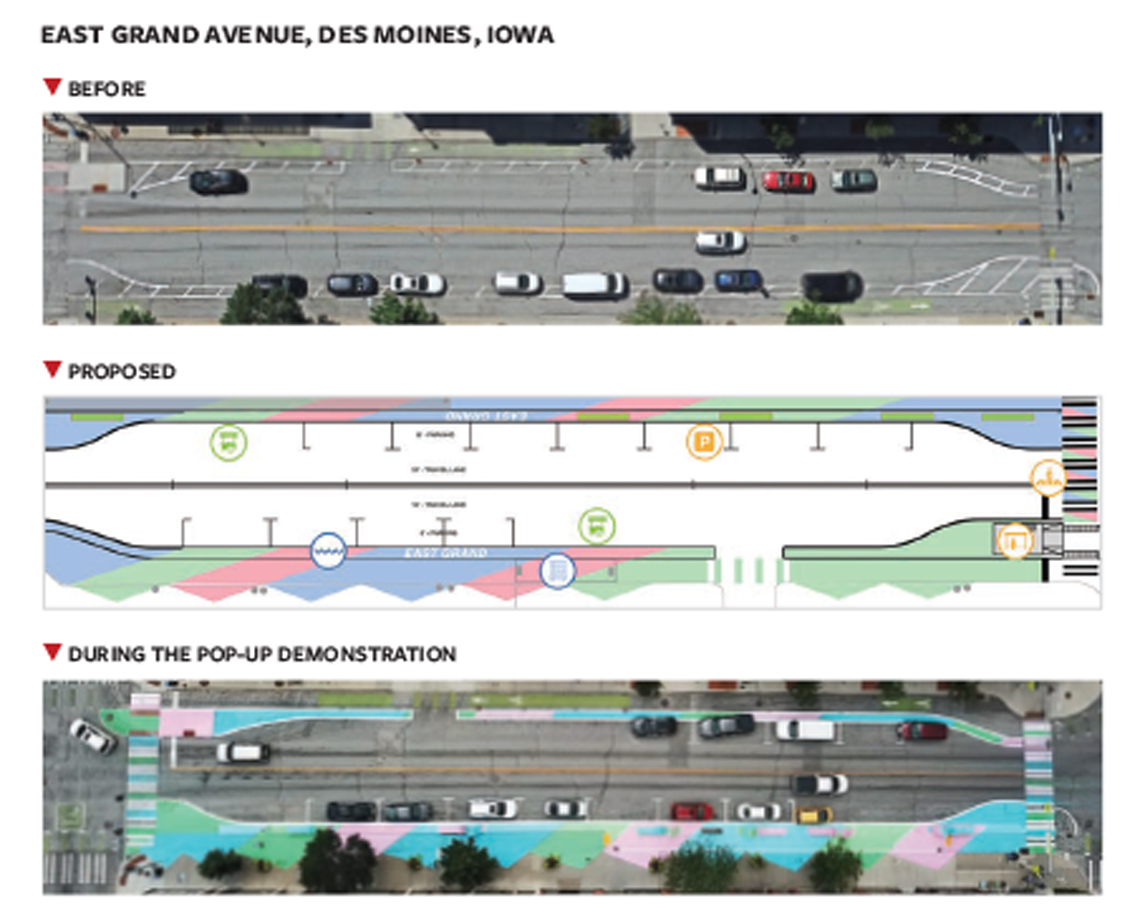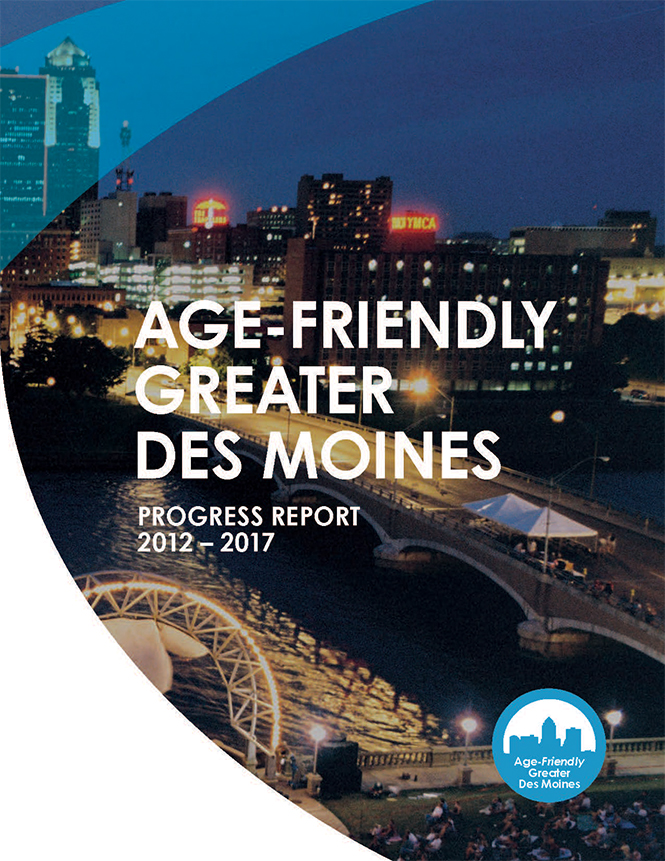Age-Friendly Greater Des Moines, Iowa
A look at what the state’s capital city has achieved since joining the AARP Network of Age-Friendly States and Communities
ACTIVITIES AS OF MAY 2020
Member Profile
The city of Des Moines is home to about 217,000 people. When combined with the surrounding Polk County area, the population of Greater Des Moines increases to 590,000 residents, about 13 percent of whom are age 65 or older. The region has the highest number of older residents compared to anywhere else in the state.
Initiative Name: Age-Friendly Greater Des Moines
Network Member Since: 2012
Government Type: Des Moines is governed by a council-manager form of government, which combines the political leadership of elected city council members with the managerial experience of an appointed local government manager. One council member is elected from each of the city’s four wards while the mayor and two council members are elected at-large. The mayor presides over the council meetings.
Reason(s) for Joining: Central Iowa’s overall population growth and demographic trends — including the movement of older Iowans into urbanized areas — indicates that an increasing percentage of the Des Moines population will consist of older residents, says initiative co-chair Kent Sovern (see below).
Community Partners
Local Leadership: The city’s age-friendly initiative was founded by:
- Yogesh Shah, M.D., one of the state’s leading geriatricians who, at the time, was the dean of international health studies at Des Moines University
- Joel Olah, Ph.D., the director of Aging Resources of Central Iowa
- Kent Sovern, then the state director of AARP Iowa, now an AARP Livable Communities Volunteer and Co-Chair of Age-Friendly Greater Des Moines
- And several appointees from the Des Moines City Manager’s office. (Other community members served on a steering committee of about 30 community leaders representing business, government, nonprofit organizations, and the philanthropic and health sectors of Central Iowa’s economy.)
The Financials: Age-Friendly Greater Des Moines was financed primarily through the general budget of AARP Iowa and support from the AARP national office. Grant funding came from the Polk County Board of Supervisors for Evolve: Reigniting Self & Community, a program for people age 50 or older who want to build community leadership skills and implement a community project. In addition to the commitment of AARP Iowa staff and volunteer resources, the initiative received in-kind contributions from each of the founding entities and many of the collaborating organizations.
Getting Started: When the age-friendly initiative began in Des Moines, there were three regional planning projects underway at the time. As Kent Sovern explains, “The steering committee’s advice to us was, ‘Let’s integrate the age-friendly plan into what’s already going on rather than start something that’s independently branded.’ After surveying the 50-plus population, we divided their recommendations into three buckets, which we named the Built Environment, the Social Capital Environment, and Health and Communications. The age-friendly volunteers were integrated into the task forces for these planning groups, which we branded as 'Age in Everything' design.”
Actions and Achievements
Age-Friendly Des Moines has published its progress report for the years 2012 to 2017. Among the accomplishments thus far:
Missing Middle Housing
A major project where “age-friendly was the principle catalyst,” says Sovern, involved a 72-acre plot adjacent to the central business district that a realty company was planning to develop into a typical suburban neighborhood.
The AARP Iowa team had been learning about Missing Middle Housing, a type of smaller-scale, multi-unit or clustered housing in livable, walkable, mixed-income urban communities. They invited architect Dan Parolek, who coined phrase, to make a series of presentations.
“We had community meetings that were attended by our partners, collaborating organizations, their leadership, the mayor. We began sending the developers information to show them there may be a market demand for this kind of housing,” Sovern explains. “Surveys of millennial and boomers were telling us the same thing. People in both age groups sought a smaller carbon footprint. They wanted to be less automobile-dependent, live in walkable neighborhoods near cultural activities and reside in mixed-use, multi-age housing. Both groups also need housing that’s more affordable than what a typical single-family home requires.
“The next day we had a luncheon with the real estate leaders involved in the downtown location. From that meeting, plans for the development, called Gray’s Station, were completely redesigned. Construction has begun on the development plan that includes mixed-use housing. Boomers and millennials are gobbling them up. The resources we brought to the table as Age-Friendly Greater Des Moines influenced community leaders.”
Better Block Project
“Complete Streets” are safe and accessible for all users and modes of transportation. Equity for all roadway users is a key element of the policy framework.
In 2017, the City of Des Moines had stalled on Move DSM, its first-ever 25-year transportation plan that would, for instance, make several roadways safer for bicycling and walking. To drum up both interest and support in Move DSM, AARP Iowa and Team Better Block staged a “pop-up” (or temporary) demonstration project on East Grand Avenue.
“We painted the street, sidewalks and created an elevated bike lane,” says AARP Iowa State Director Brad Anderson about the office’s efforts in July 2018. “We built benches and planters, made signs, brought in trees and outdoor tables and chairs for several restaurants. Those were just a few of the improvements that could improve public safety, beautify the block and benefit local businesses. “
And it worked. In November 2018 Move DSM was approved unanimously by the Des Moines City Council, but it soon became clear funding the plan would be an issue. Des Moines was one of only a few Iowa communities that did not have a local option sales tax to fund road improvements. AARP and Age-Friendly Des Moines partners teamed up with city leaders to successfully pass a local option sales tax in March 2019, which has led to funding for sidewalks, crosswalks and safe, Complete Streets. A few months later, residents turned out in record numbers to vote for funding the measure.
This policy changes Move DSM and was a major victory for Age-Friendly Greater Des Moines. “It takes time and money to make Complete Streets,” adds Anderson. “But we must make Complete Streets a priority if we want to continue to maintain Des Moines’ status as a city on the move.”
Community Mapping
Age-Friendly Greater Des Moines identified three low-income neighborhoods — Capitol East, Capital Park, Martin Luther King, Jr. Park — that were underserved by public assets.
As Sovern describes, “We asked the Des Moines Area Metropolitan Planning Organization, ‘Can we map these neighborhoods in such a way that we can see the location of all the grocery stores, the community centers, the age-designated senior housing and urgent care clinics?’ We described the process as looking through an age-friendly lens. Think about the 8-year-old and the 80-year-old, and look at this neighborhood.”
“Mapping out the resources or lack thereof were a physical representation of what people inherently knew — but it became real. That exercise elevated people’s understanding of what we were trying to do more than anything else.”
After seeing the mapping results, the city dedicated a staffer to work with the three neighborhoods. The project was called Viva East Bank. The age-friendly team engaged the local faith-based communities.
“We were known within the business community as people with juice. In these three neighborhoods no one knew us from Adam,” says Sovern. “The faith-based communities gave us street cred. Des Moines reaped the benefits. The work we did on the front end was the catalyst.”
The three East Bank neighborhoods had been hit hard by the collapse of the housing market in the late 1990s and the recession that followed, leaving behind foreclosures, vacant homes and blight. According to an Iowa Public Radio report in 2017, “Since 2014, when Viva East Bank began to roll, nearly 200 homes have been repaired, 17 new houses built and 21 abandoned properties torn down."
Viva East Bank wrapped up at the end of 2018. Amber Lynch, who had led the project, explains, “It was always envisioned as a temporary initiative for the city and lessons learned from it helped inform a broader neighborhood-based strategy and a new organization called Invest DSM.”
Formed in 2019, the not-for-profit Invest DSM is a jointly funded collaboration between the City of Des Moines and Polk County with the goal of bringing, says Lynch, “a renewed commitment to neighborhood revitalization.” Invest DSM has a program budget of $50 million over 10 years is serving the neighborhoods of Oak Park/Highland Park, Drake, Franklin and Columbus Park in order to “strengthen middle market neighborhoods,” which the organization’s website describes as “neither the strongest in the city in terms of residential property conditions, nor the weakest.”
Helping Small Businesses
A fun effort that has had a modest impact is the Age-Friendly Business Project, in which volunteers with business expertise visited public-facing businesses to evaluate the space’s physical layout and the customer experiences. They then provided recommendations for how to improve the business’s age-friendliness.
For instance, restaurant menus are often beautiful but illegible. “The ambience is lovely, but the space is so dark you can’t see,” Sovern notes, adding that, “poor acoustics make it hard to carry on a conversation. When calling the restaurant, the phone system is overly complex and doesn’t connect to an actual person.”
The businesses that became more age-friendly received a door sticker that tells customers, “You are entering an age-friendly business.”
One of the very first businesses the effort helped was the AARP Iowa office itself! As a result of the volunteer assessors’ recommendations, the office:
- Enlarged the words on the sign in the front of the AARP building so people can more easily locate the office
- Added seating in the foyer so visitors awaiting transportation wouldn’t have to stand
- Reduced tripping hazards by painting the sloped or graduated walkway curbs in a very visible yellow
(Seeing the state office’s solution, R&R Realty Group, the company that led the redesign work decided to make the same changes at all of its locations.)
Lessons Learned (and Advice for Others)
Fully engage local government partners from the get-go.
Age-Friendly Iowa
Visit AARP Iowa
Learn about the AARP Network of Age-Friendly States and Communities
Check out the network's Member List
“When we first approached the City of Des Moines about engaging in the age-friendly effort, it laid the leadership on the founding organizations — AARP, Aging Resources of Central Iowa and Des Moines University,” Sovern explains. “The city became more invested after seeing the successes from a couple years' work.”
Sovern says Age-Friendly Greater Des Moines couldn’t have pursued its work as aggressively as it did without the backing of the city. “You need a real live physical and fiscal commitment from the city or county,” he says, adding that “it took a while to really get the machinery of local government — the planning department, the engineering department, and so on — to be behind us.”
So what convinced the city to engage and get active?
“There had been a lot of naysayers during the rewrite of the Comprehensive Plan and the supporting municipal code,” Sovern recalls. “But our volunteers began voicing support of the city’s vision for a form-based code with Complete Streets. We emphasized including health solutions in policies where they’d been absent. The mayor, City Council and planning staff recognized the value of our support. It was no longer only the professionals saying this is the way to go. When the age-friendly volunteers appeared, it showed that citizens were saying this is the way to go.”
Reporting by Amy Lennard Goehner
Stay Informed
The weekly, award-winning AARP Livable Communities e-Newsletter provides local leaders with information and inspiration for making their town, city or neighborhood more livable for older adults and people of all ages. Subscribe today!
AARP.org/Livable
Enter a topic, name, place, etc.








